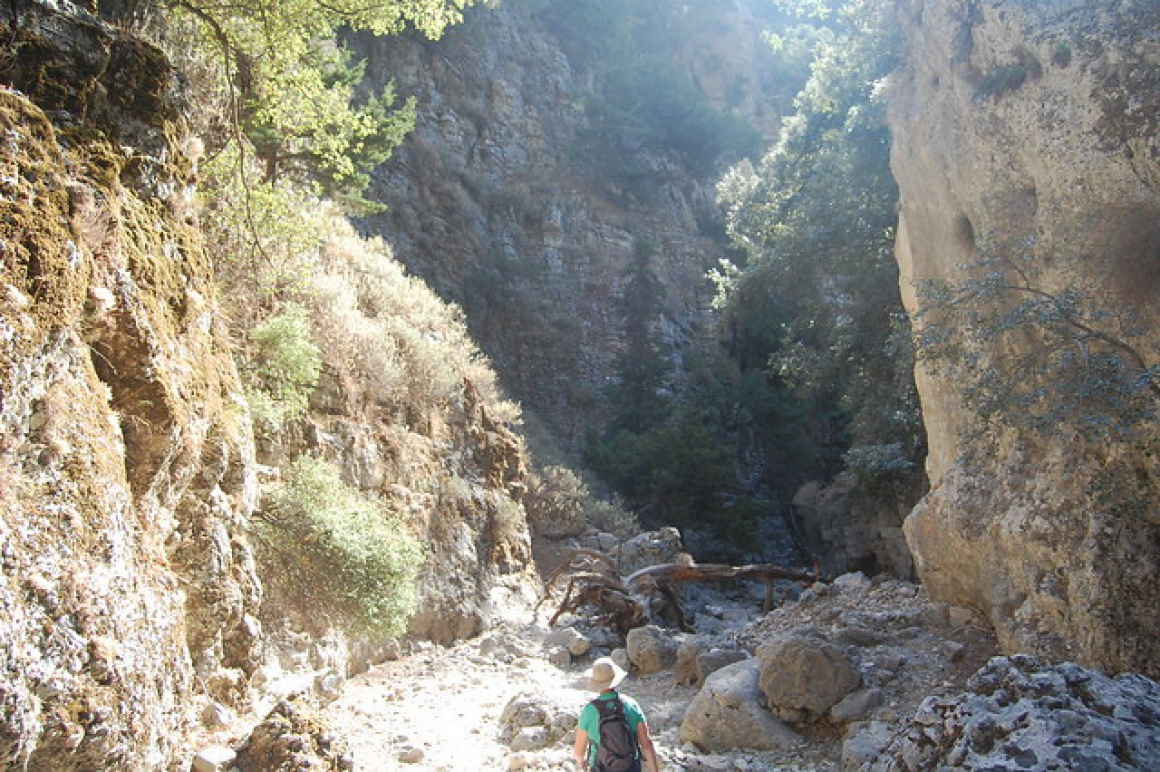High in the mountains of southwestern Crete, the earth opens into a dramatic corridor of stone – this is Imbros Gorge, a seven-mile (11 km) slice through the rugged White Mountains that offers hikers a journey through both stunning natural beauty and living history. While less famous than its “big brother” Samaria Gorge, Imbros has a magic all its own. It is narrower and more intimate than Samaria Gorge, with towering walls that at one point squeeze to under 2 metres apart, creating a wondrous slot canyon. Dappled light filters down to the rocky trail, which descends gently from the mountain village of Imbros to the seaside hamlet of Komitades. Along the way you'll walk on ancient stone paths, pass under natural rock arches, and step over smooth pebbles polished by millennia of water flow. Imbros is an accessible adventure – easier and open year-round – that invites you to follow in historic footsteps amid breathtaking scenery.
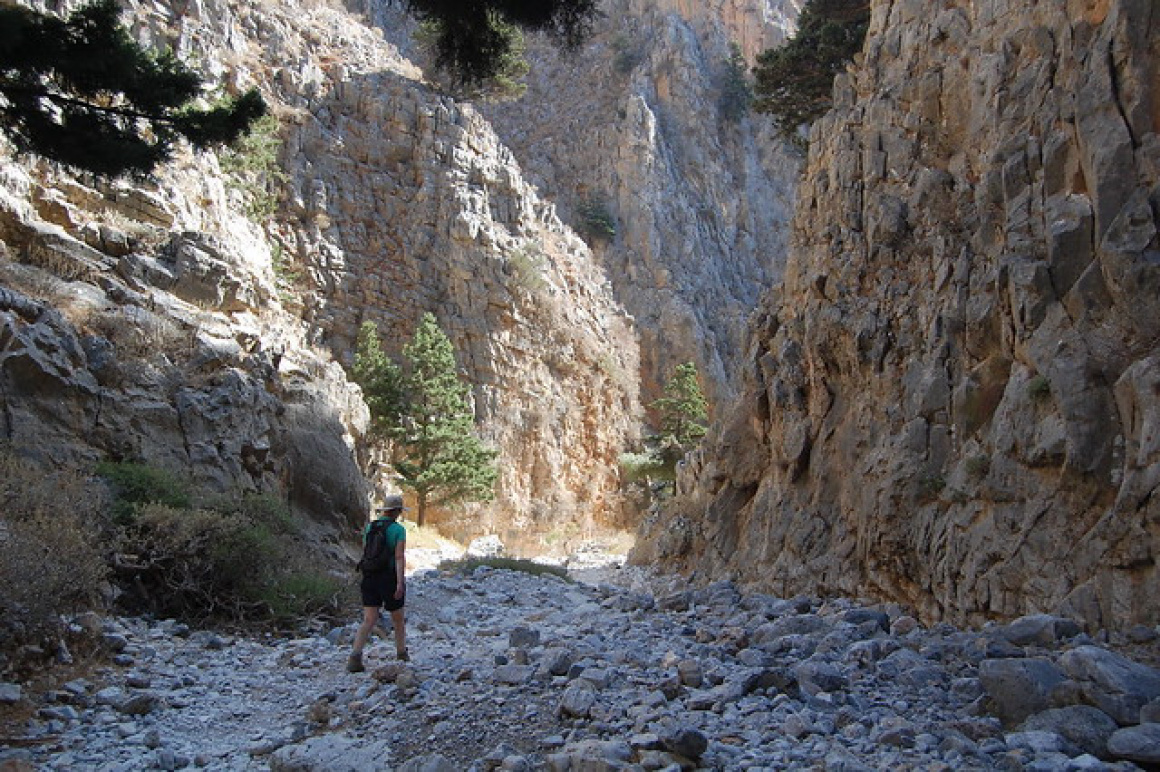
 '2013 10 13_crete_0065' - Attribution: Pete McClymont
'2013 10 13_crete_0065' - Attribution: Pete McClymontThe Imbros Gorge trail begins in the quiet village of Imbros at about 780 m elevation, where a small kiosk marks the entrance (a modest ticket fee is collected for trail maintenance). Almost immediately, you are enveloped by the gorge's steep walls and the scent of pine and wild herbs. Gnarled old cypress and oak trees cling to the cliffs, providing welcome patches of shade. In spring, the gorge floor is sprinkled with wildflowers and oregano. As you venture deeper, the limestone walls grow taller and closer. Imbros is famed for its narrow passages – about an hour in, you'll reach the most iconic stretch where the sandstone‑orange walls constrict to only 1.6 metres wide, soaring 300 metres overhead. Walking through this section feels like entering a secret hallway in nature's cathedral.
Imbros Gorge has been a main thoroughfare since antiquity. Before the modern coastal roads, this gorge was the primary route connecting the north and south of western Crete. You can still spot traces of the old stone‑paved mule path that once linked the town of Chania to the port of Chora Sfakion – worn cobbles underfoot in certain spots remind you that traders, villagers, and even invading armies have trod this way. The gorge's name, Imbros, is said to derive from an ancient village or perhaps from the word for “ambush,” hinting at its strategic importance (indeed, legends tell of bandits who would prey on unwary Ottoman tax collectors here in the 19th century!).
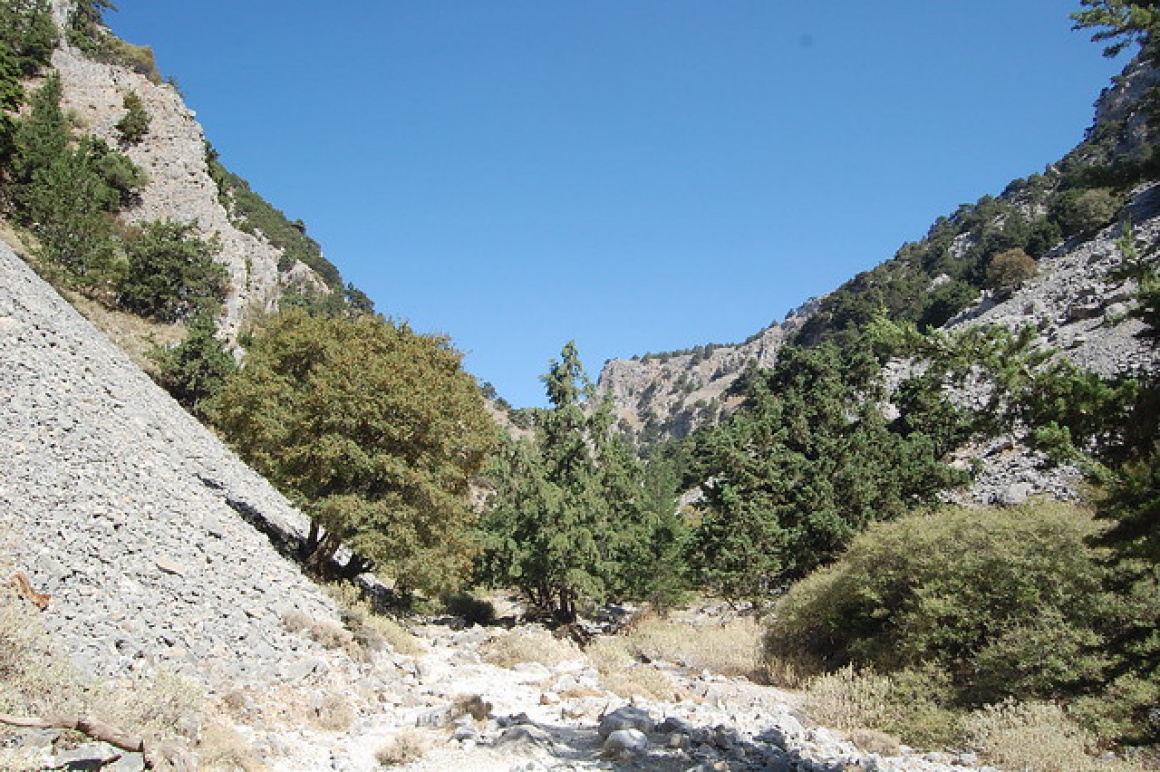
 '2013 10 13_crete_0061' - Attribution: Pete McClymont
'2013 10 13_crete_0061' - Attribution: Pete McClymontOne of Imbros's most poignant historical episodes occurred during World War II. In May 1941, after the fall of Crete, the gorge became an escape route for Allied troops retreating to be evacuated at Sfakia. Close to 20,000 soldiers from Britain, Australia, and New Zealand struggled through Imbros's rocky terrain under bombardment. Many exhausted men were aided by local Sfakiots guiding them to safety. As you walk, imagine that somber procession – hungry, wounded soldiers making their way under these same cliffs, desperate to reach the sea. Hikers today often come across small memorial plaques or engraved stones left in remembrance. Knowing this history lends a humbling gravity to the hike; you're not just enjoying nature's beauty, you're walking through a chapter of history. Imbros Gorge truly is a place where every twist and turn has a story.
Hiking Imbros is usually a half‑day endeavour (about 2 to 3 hours of walking), making it perfect for families or those not up for the much longer Samaria Gorge trek. The path is mostly downhill – you'll descend roughly 600 m over the course of 8 km (the walking distance through the gorge itself is around 8 km, though including the stretch to Komitades it's closer to 11 km). The terrain is uneven but not too challenging; sturdy trainers or hiking shoes suffice. As you set off from Imbros village, the first section is relatively wide and filled with light. You'll notice black goats skipping among the rocks above you, and swallows darting across the sky far overhead. In places, the gorge walls form abstract patterns and wave‑like striations – perfect for photos.
About halfway, near a spot called Mesofarango, you encounter an impressive natural stone arch on the right side of the trail, a sort of grand gateway Mother Nature carved. This is often a rest point for hikers to snap pictures and marvel at the geological artistry. Beyond the arch, you officially enter the narrowest part of Imbros. Here the air cools, and you can sometimes hear the gentle drip of water seeping from the rocks (Imbros has springs that flow seasonally; in high summer it's usually dry underfoot, but after rains small streams may trickle through). The closeness of the walls gives a sense of intimacy – unlike some gorges where scenery is distant, here you touch the textured rock as you navigate through bends. Look for tree roots dramatically twisting down the cliffs in search of water, and small caves used as shelter by goats or the occasional shepherd.

 '2013 10 13_crete_0032' - Attribution: Pete McClymont
'2013 10 13_crete_0032' - Attribution: Pete McClymontAs you walk, every corner reveals new tableaux: a fallen boulder wedged between the walls here, a cluster of oleander bushes there, perhaps a shy Cretan wild sheep (kri‑kri) peeking before darting away. Imbros is quieter than other popular hikes; you might only encounter a few groups along the way, especially if you start early. This tranquillity allows you to absorb the subtle sounds – cicadas buzzing, wind rustling the treetops high above, and your own footsteps crunching on gravel. The gorge widens again in its last section. You'll know you're nearing the end when you see a ruined stone house (once a toll station or wayside inn in centuries past) and the brilliant blue sliver of the Libyan Sea appearing ahead through the valley.
Exiting the gorge, you arrive at Komitades village. Here, a handful of tavernas await, offering cold drinks, hearty Sfakian food, and a warm welcome. Most hikers celebrate with a fresh orange juice or a cold beer, and perhaps a plate of Sfakian pies (thin cheese pies drizzled with honey) – you've earned it! If you started early, the whole walk may be completed by lunchtime, giving you time to relax at a taverna and share trail tales with fellow hikers. The sense of accomplishment is real; while Imbros is not extremely difficult, you have journeyed through an ancient path steeped in natural splendour and human drama.
Getting There & Back:
Imbros Gorge is linear, running north‑to‑south. Most people begin at Imbros village (north end) and walk down to Komitades (south end). If you have a rental car, one common strategy is to park in Komitades (finish point), then take an early morning taxi up to Imbros village to start the hike. Alternatively, park at Imbros, hike down, and hire a local “taxi” (often a friendly local with a pickup truck) in Komitades to shuttle you back up – this is quite common and costs around €5‑10 per person. During high season, there's also a public KTEL bus from Chania to Imbros in the morning and a return bus from Chora Sfakion (5 km from Komitades) in late afternoon, but schedules are limited. Many visitors opt for an organised tour from Chania or Rethymno which handles all transport – a bus drops you at Imbros and meets you in Komitades or Sfakia after.
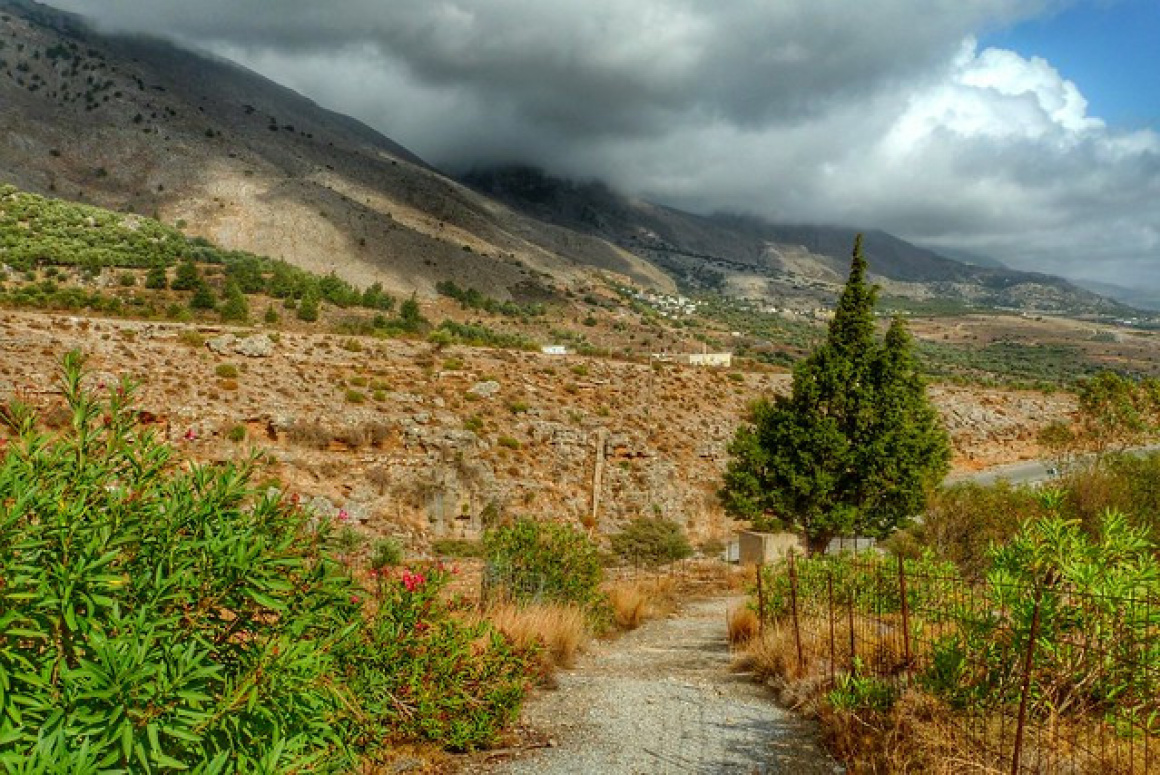
 'Imbros gorge Crete' - Attribution: rost8668
'Imbros gorge Crete' - Attribution: rost8668When to Hike:
Imbros Gorge is typically open year‑round, unlike Samaria Gorge which closes in winter. This makes it a great option in spring or late autumn when higher gorges are off‑limits. However, avoid very rainy days – heavy rain can cause rockfalls in any gorge. In spring (April‑May) you'll enjoy blooming vegetation and possibly small streams flowing, but the trail could be slippery with mud or wet stones. Summer hikes are hot but Imbros provides decent shade in parts; start early (8–9am) to beat both heat and any crowds. Autumn offers comfortable temperatures and the golden hues of drying foliage. In winter, check weather and be equipped for possible running water in the gorge and cooler temperatures.
Trail Difficulty:
Imbros is considered an easy‑to‑moderate hike. No scrambling or technical sections are required – it's a well‑trodden path. It descends ~600 m steadily but not steeply. Good footwear is important as the path is rocky; trainers with grip or hiking boots are fine (sandals are not!). Families with children often tackle Imbros successfully – kids generally love the sense of adventure in the narrow passages (just keep an eye on them on uneven surfaces). If you have knee issues, trekking poles help for the downhill. Carry at least 1.5 liters of water per person (you can refill at a spring near the middle if it's running, but in summer that may be dry). There are no facilities inside the gorge – once you depart Imbros village, there's nowhere to buy anything until Komitades – so bring snacks. Mobile signal is patchy; do not count on phone service in the middle of the hike.
Highlights to Look For:
Keep your eyes peeled for the stone arch (approx. 5 km in) – it's on the right side and is an Instagram‑worthy spot. A section locals call “Stenádia” is the narrowest point – here, try stretching your arms and touching both walls; many can! Notice the old road mile markers: carved stones with faint inscriptions can still be found trailside in a couple of places, remnants from when Imbros was like a mountain highway. Bird enthusiasts might spot griffon vultures circling high above the rim – these huge birds nest in the White Mountains and often glide over Imbros around midday. And as you approach the exit, admire the view opening up: beyond Komitades, you can see the blue Libyan Sea and, to the east, the coastal plain leading to Frangokastello (site of a famous Venetian fortress on the beach). This vista of sea framed by steep slopes is a reminder of how dramatically the terrain transitions from mountains to coast in Crete.
Nearby Attractions:
Imbros Gorge lies in the Sfakia region, a remote and storied part of Crete. After your hike, if you have time, consider exploring a bit of Sfakia. The coastal village of Chora Sfakion (just 5 km from Komitades) is a sleepy harbour where you can swim in clear waters or catch a ferry to Loutro (a roadless village only reachable by boat or a long hike). Eastward, about a 20‑minute drive, is Frangokastello Castle, an imposing 14th‑century Venetian fort right by a sandy beach – it's worth a stop for a dip and to hear the legend of the ghostly “Drosoulites” apparitions said to appear at dawn in May. If you're a gorge enthusiast, another shorter but spectacular chasm, Kotsifou Gorge, is north of Sfakia on the road to Plakias. And for history buffs, ask locals in Komitades about the WWII monument in the area – many villages here have small memorials to those events in 1941.
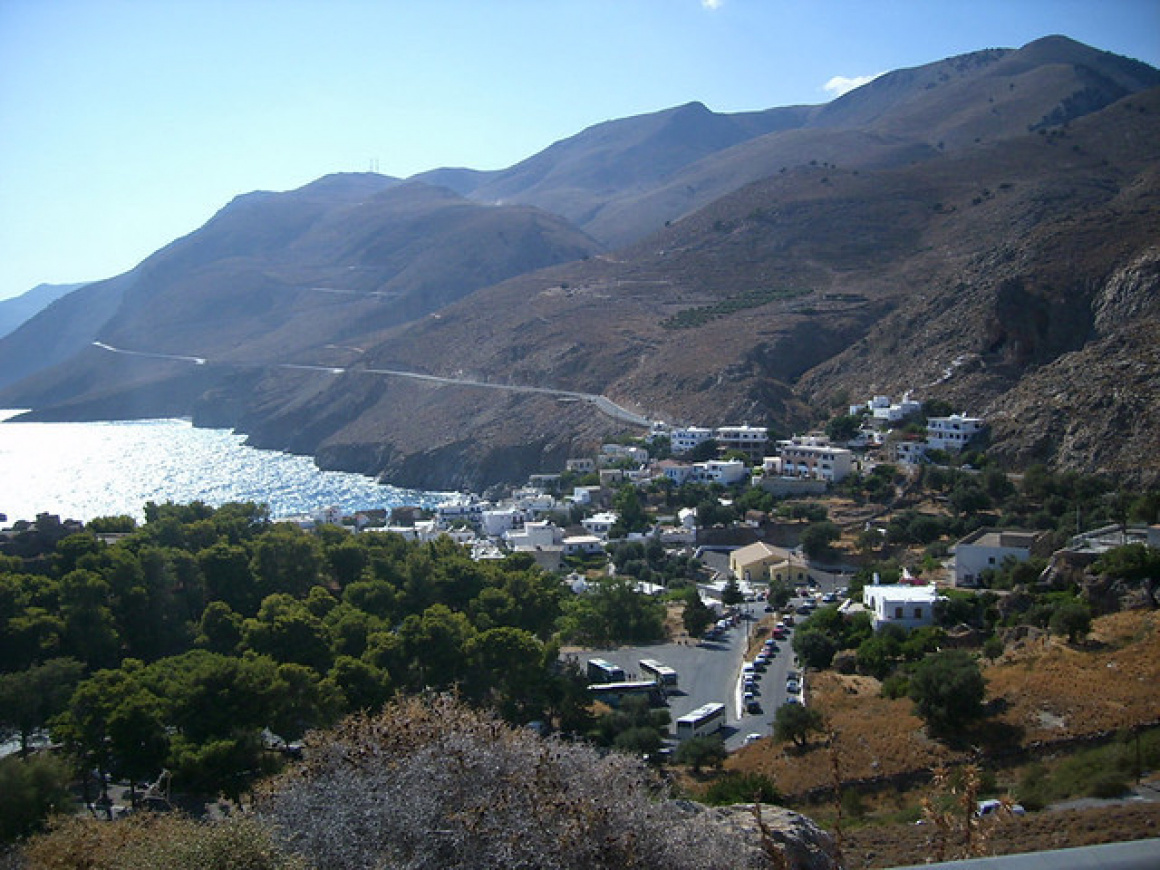
 'Sfakia' - Attribution: mariettaki
'Sfakia' - Attribution: mariettakiWhile many people do Imbros as a day trip from Chania or Rethymno, staying in the region for a night immerses you in authentic Sfakian culture. Imbros village itself has a couple of basic guesthouses and traditional tavernas – nothing fancy, but you'll get a hearty meal and a quiet night under starry skies at elevation. If you prefer to be by the sea after your hike, Chora Sfakion offers a few family‑run hotels and rooms. Waking up to the sound of gentle waves in Sfakia is delightful, and from there you can easily hop on a morning ferry to Loutro or Agia Roumeli (Samaria's exit point) for more exploration.
For a bit more comfort, the village of Vrisses (about 30 km north of Imbros, on the main road) has some inns and is famous for its yogurt – a nice stop on the way back. However, one of the best local options is to stay in Frangokastello, about 20 minutes east of Komitades along the coast. There are a handful of small hotels and apartments near Frangokastello's beach. Imagine relaxing on a terrace with the Venetian castle in view, recounting your gorge hike as the sun sets! Frangokastello's beaches are much quieter in the evenings once day‑trippers leave.
Staying overnight in the area also gives you the chance to enjoy a true Sfakian dinner. The local tavernas in Komitades or Sfakia serve specialties like “sfakianes pites” (cheese pies with honey) and slow‑cooked lamb with wild herbs. The hospitable owners might share a bit of the local tsikoudia (raki) and some tales of Sfakia's proud history. By morning, you'll be greeted perhaps by the distant clanging of goat bells and the crisp mountain‑coastal air unique to this region. Tip: If you stayed up in Imbros village, you could even hike the gorge in reverse early (from Komitades back up to Imbros) while it's cool and quiet, though it's an uphill trek that way. Most will stick to the traditional downhill route – but either way, an overnight in Sfakia allows you to experience Imbros Gorge unhurried, at the gentle pace of Cretan mountain life.


